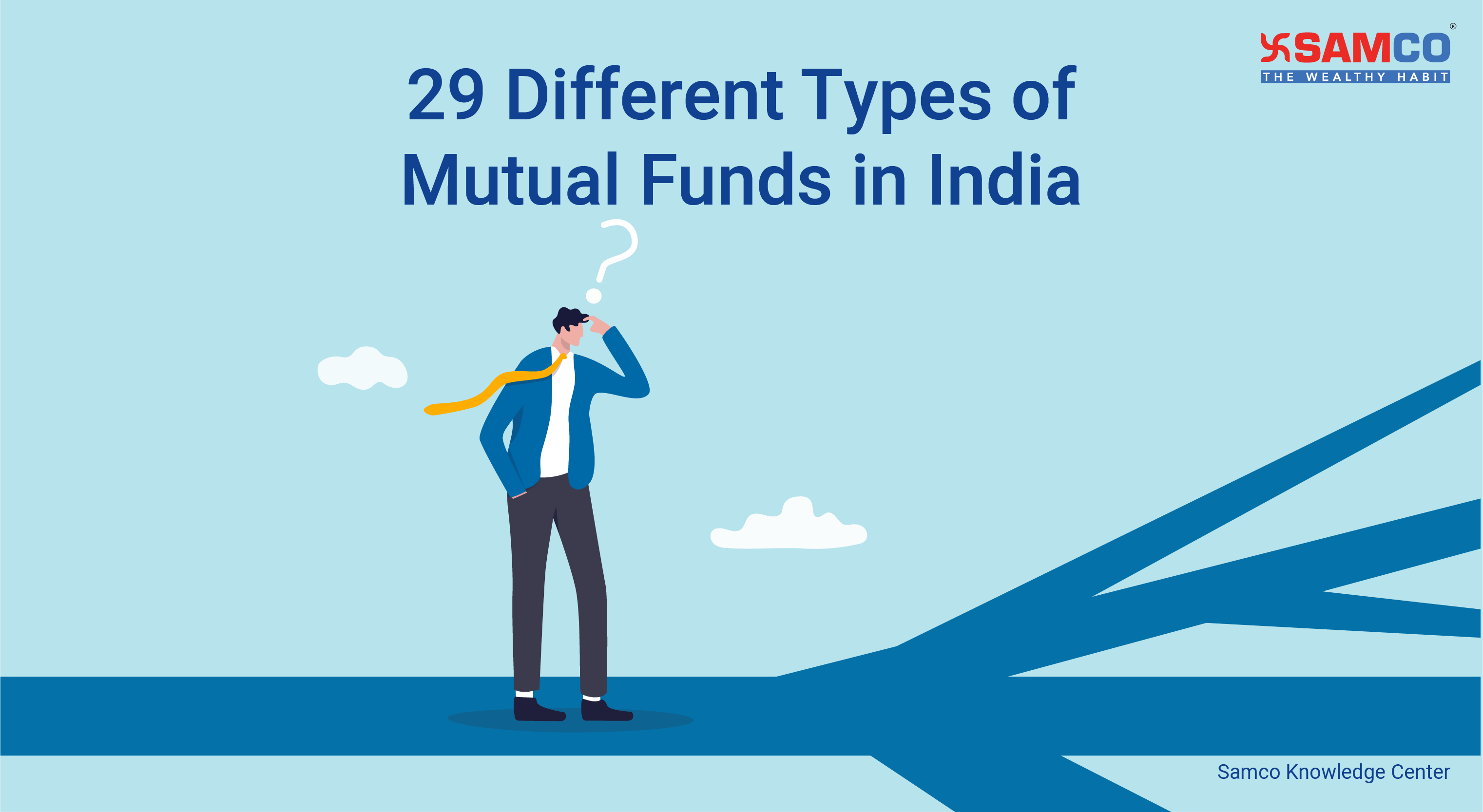 Mutual funds have evolved tremendously over the years. In the beginning, there were only two main types of mutual funds in India – Equity funds and Debt funds. High-risk investors would choose equity funds. Whereas debt funds were ideal for low-risk investors.
But then came a third type of mutual fund – hybrid funds. These were suitable for investors who wanted to take moderate risk… neither too high nor too low.
As the needs and demands of investors increased, there was an explosion in the different types of mutual fund schemes. This was of course great news for investors.
But with diverse types of mutual funds came confusion. Investors were and still are confused about the meaning, scope or benefits of the different types of mutual fund schemes.
But it’s time we put an end to this confusion.
In today’s article, we will answer all your queries on the different types of mutual fund schemes in India. We will look at their meaning, investment strategy and benefits. Let’s begin.
In this article:
Mutual funds have evolved tremendously over the years. In the beginning, there were only two main types of mutual funds in India – Equity funds and Debt funds. High-risk investors would choose equity funds. Whereas debt funds were ideal for low-risk investors.
But then came a third type of mutual fund – hybrid funds. These were suitable for investors who wanted to take moderate risk… neither too high nor too low.
As the needs and demands of investors increased, there was an explosion in the different types of mutual fund schemes. This was of course great news for investors.
But with diverse types of mutual funds came confusion. Investors were and still are confused about the meaning, scope or benefits of the different types of mutual fund schemes.
But it’s time we put an end to this confusion.
In today’s article, we will answer all your queries on the different types of mutual fund schemes in India. We will look at their meaning, investment strategy and benefits. Let’s begin.
In this article:

What is a Mutual Fund?
A mutual fund is an investment vehicle which pools money from various investors. A fund manager decides which share or bond to buy from this pool. The gains or losses of the fund are shared among all investors equally. Think of a mutual fund like a piggy bank. But this piggy bank is not just yours. It is shared by lakhs of investors. They all deposit (invest) money in this piggy bank. The total money collected is then used to buy shares or bonds or both. Watch this video to learn the basics of mutual funds.There are more than 29 different types of mutual funds in India. For ease of understanding, we have divided these different types of mutual funds on the basis of:
- Fund Structure
- Asset Class
- Risk
- Investment Objective
- Specialty
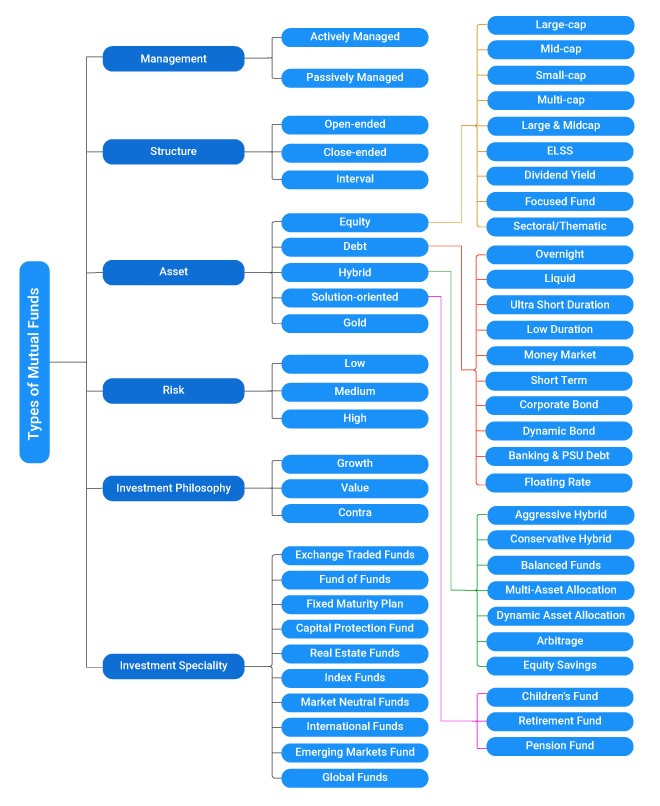
Types of Mutual Funds in India Based on Fund Structure:
- Open Ended Funds: These funds are available for investment and redemption throughout the year. This means, an investor can buy and sell units of an open-ended fund anytime without any restrictions. There is no lock-in period and investors have the freedom to buy and sell at their will.
- Close Ended Funds: As the name suggests, these funds are close-ended in nature. So, investors can buy them during a specific period only. Similarly, they can be sold only on a specific maturity date. However, these funds are listed on stock exchanges but have low trading volumes.
- Interval Funds: Interval funds are a mix of open and close ended funds. They are available for purchase at multiple but specific intervals.
Types of Mutual Funds in India Based on Asset Class:
- Equity Funds: These funds invest in stocks or equities of companies listed on the stock exchange. They have the potential to deliver high returns but also carry high risk. Equity funds are further divided on the basis of market capitalisation as:
- Large cap funds – 1st to 100th companies listed on the exchange.
- Midcap funds – 101st to 250th companies listed on the exchange.
- Small cap funds – 251st onwards companies listed on the exchange.
Performance of Large, Mid & Small cap funds in India
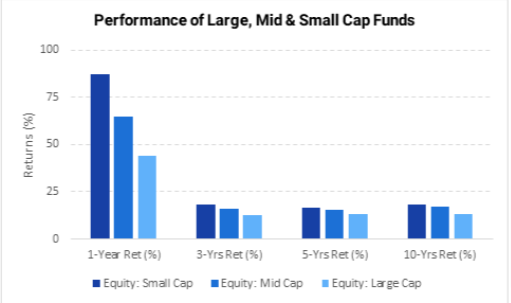 *Data as on 11th August 2021 **Source: RankMF
There are various other types of equity funds which are permutations and combinations between large, mid and small cap funds.
*Data as on 11th August 2021 **Source: RankMF
There are various other types of equity funds which are permutations and combinations between large, mid and small cap funds.
- Large & Midcap Fund: These funds have to compulsorily invest minimum 35% in large cap and 35% in midcap stocks. They are safer than pure midcap funds but riskier than pure large cap funds.
- Multi-cap Fund: These funds invest minimum 65% of the corpus across large, mid and small cap stocks.
- Flexi-cap Fund: This is a new category introduced by SEBI in 2020. Here, the fund manager has the freedom to shift the corpus dynamically across large, mid and small cap stocks.
- Focused Fund: These funds can invest in only 30 stocks belonging to any particular sector – large, mid or small cap.
- Dividend Yield Fund: These funds invest minimum 65% of the corpus in dividend yielding stocks. They are perfect for investors who want regular income from mutual funds.
Watch this video to learn what are debt funds.
Debt funds can be further classified on the basis of:- Macaulay Duration of Papers
| Type of Debt Fund | Investment Strategy |
| Short Term Debt Fund | Investment in debt instruments with Macaulay duration between one to three years. Short term debt funds are more in demand when interest rates are rising. |
| Medium Duration Debt Fund | Investment in debt instruments with Macaulay duration between three to five years. |
| Medium to Long Term Debt Funds | Investment in debt instruments with Macaulay duration between four to seven years. |
| Long Duration Fund | Investment in debt instruments with Macaulay duration more than seven years. long term debt funds are preferred in a falling interest rate scenario. |
| Dynamic Bond Fund | Invests across duration (short term or long-term papers) |
| Floater Fund | Invests minimum 65% in floating rate instruments. |
- Type of Borrower
| Type of Debt Fund | Type of Borrower |
| Corporate Bond Fund | Invests 80% of the corpus in AAA rated papers only. |
| Credit Risk Debt Fund | Invests minimum 65% of its assets in low-rated papers yielding high returns. |
| Banking & PSU Debt Fund | Invests minimum 80% of assets in papers issued by banks & public sector units (PSUs). |
| Gilt Funds | This is one of the lowest risk mutual funds in India. Gilt funds investment in only government securities. They carry the sovereign guarantee and have zero credit risk. Gilt funds invest in long-term government securities making them more prone to interest rate risks. |
Performance of Debt Funds in India
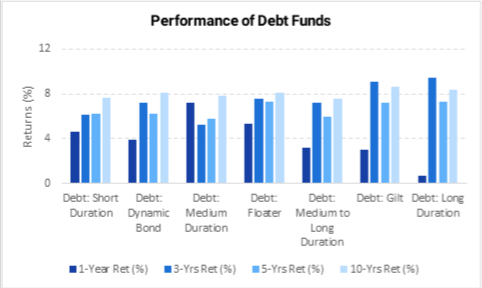 *Data as on 11th August 2021 **Source: RankMF
*Data as on 11th August 2021 **Source: RankMF
- Money Market Funds: These funds invest in liquid instruments like treasury bills, commercial papers, certificates of deposits etc. They are considered to be the safest amongst all other types of mutual funds. This is because they invest in securities which mature in less than 91 days. So, they face very little interest rate risk.
Performance of Money Market Funds in India
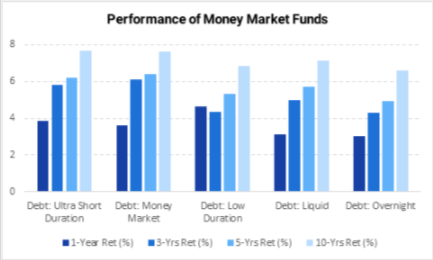 *Data as on 11th August 2021 **Source: RankMF
*Data as on 11th August 2021 **Source: RankMF
Money market funds can be further divided as:
| Type of Money Market Fund | Maturity Period of Underlying Papers |
| Overnight Funds | 1 day |
| Liquid Funds | 1 day to 91 days |
| Ultra Short-Term Debt Funds | 3 months to 6 months |
| Low Duration Funds | 6 months to 1 year |
- Hybrid Funds: These funds are a combination of equity funds and debt funds. They provide best of both the worlds – capital appreciation from equity shares and stability from debt instruments. There are seven different types of hybrid funds in India:
| Type of Hybrid Fund | Equity Allocation | Debt/Gold/Cash Allocation | Risk |
| Aggressive Hybrid Fund | 65-80% | 20-35% | High |
| Balanced Advantage Fund | 40% | 60% | Medium |
| Arbitrage Fund | - | 100% in cash | Low |
| Dynamic Asset Allocation Fund | 0-100% | 0-100% | Medium-High |
| Multi Asset Allocation Fund | Minimum 10% | Minimum 10% Minimum 10% in Gold | Medium- High |
| Conservative Hybrid Fund | 10-25% | 75-90% | Low-Medium |
| Equity Savings | 65-100% | 0-35% | Low-Medium |
Performance of Hybrid Funds in India
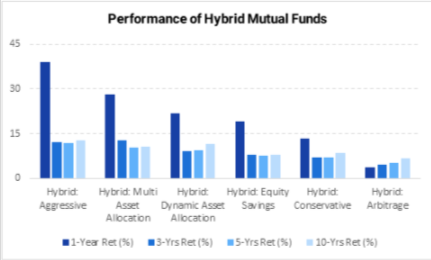 *Data as on 11th August 2021 **Source: RankMF
*Data as on 11th August 2021 **Source: RankMF
Types of Mutual Funds in India Based on Investment Objectives:
Everyone invests in mutual funds for different reasons. Senior citizens are not looking for aggressive growth. They just want stable returns. Similarly, a young investor might demand a high-growth mutual fund. Luckily, there are different types of mutual funds for different investment objectives. 1. Growth Funds: These funds invest in high growth stocks which are trading at high price to earnings ratio (PE). These stocks have an above-average growth potential and are favourite among long-term investors. 2. Value Funds: These funds must invest minimum 65% of their corpus in value stocks. These are stocks which are trading at a discount to their intrinsic value. Value funds help in limiting downside risk. 3. Contra Funds: These funds invest minimum 65% of their corpus in stocks using a contrarian approach. Since they are taking an opposite call on the stocks, contrarian funds are highly risky. 4. Income Funds: These funds aim to generate regular income and mostly invest in government securities, corporate bonds, and money market instruments. They provide stable returns with low risk. But they carry high interest rate and credit risk. [Read More: Risks in Debt Funds] 5. Liquid Funds:Considered to be the safest type of mutual fund, liquid funds invest in liquid instruments with short maturity i.e. less than 91 days. They provide 1% or 2% higher returns than savings account with almost no risk. 6. Tax Saving Funds (ELSS):This is a special type of mutual fund. It is mostly used by investors to save tax. ELSS funds also invest in stocks like an equity fund. But they have a compulsory lock-in period of three years. You cannot sell your ELSS funds before three years under any condition. But the investment you make is eligible for deduction up to Rs 1.5 Lakhs under section 80C of the Income tax Act, 1961. [Read More: Best ELSS funds in 2021] 7. Capital Protection Fund: This type of mutual fund is perfect for low-risk investors. The aim of this fund is to protect the invested capital. This is why, it invests almost 80% of the corpus in fixed income instruments like bonds, debentures etc. The remaining 20% is invested in equity shares. This ensures that the principal is protected plus investors make a little more return from the equity portion. 8. Fixed Maturity Plans (FMPs): These funds invest in only fixed income instruments like bonds, debentures etc. They are closed-ended funds with a lock-in period. These funds mature when their underlying papers mature. 9. Pension Funds:These are great for retirees or senior citizens. Their objective to provide financial stability post-retirement.Types of Mutual Funds in India Based on Speciality:
- Sector Funds: These are riskiest amongst all other types of mutual fund schemes. They invest in specific sectors like auto, pharma, etc. Since, all stocks in a sector behave in the same manner, sector funds are less diversified. This is why they carry very high risk. Only aggressive investors with long-time horizon should invest in sector funds.
- Index Funds: These funds are passively managed and track a particular index like . Their purpose is to leverage the movement of the indices which are a bit easy to predict. They carry lowest expense ratio among all other types of mutual funds.
- Fund of Funds: These funds invest in other mutual funds. Its return is dependent on the performance of the fund in which the money is invested in. They are also known as multi-manager funds. But, investors of these funds have to pay double expense ratio, which is not ideal.
- Emerging Market Funds: These funds invest in emerging markets like China, Indonesia, Vietnam etc. This is done after in-depth assessment of future growth opportunities. These funds are very risky as exposure to political and economic instability is high.
- International Funds: These funds invest in good companies that are located internationally. For example: ICICI Prudential US Bluechip Fund invests in stocks of Amazon, Pfizer, Intel Corporation etc.
- Real Estate Funds: These funds invest in companies that are in the real estate sector. They can invest in realtors, builders, project management companies, and even loan providers.
- Commodity Focused Stock Funds:These funds invest in companies that are involved in mining or producing commodities such as gold, crude oil, coal, corn, soy, etc. Investors must invest 5%-10% of their portfolio in commodity funds like gold for portfolio hedging.
- Asset Allocation Funds: There are two types of Asset allocation funds - target date fund and the target allocation fund. Here, the fund manager dynamically alters asset allocation between equity, debt, gold and hybrid based on market movements.
- Exchange-Traded Funds (ETF): These are basically index funds that are listed and traded on exchanges like normal stocks. An ETF is a basket of stocks that mirrors an Index, like Nifty 50. They are ideal for passive investors who do not want to beat the market returns.
Types of Mutual Funds in India Based on Risk:
Risk appetite of investors keeps on changing. Some investors are comfortable with high risk. Whereas some investors lose their sleep if the fund falls by even 0.1%. Age is also a key factor here. As investors grow older, their risk profile changes from high risk to medium or low risk. Based on risk profile, there are three types of mutual fund schemes.- Low Risk:These funds carry low risk and are suitable for conservative investors who want to earn returns like Public Provident Fund (PPF) and bank fixed deposits (FD) without much risk. Liquid funds, debt funds and gilt funds are examples of low risk funds.
- Medium Risk: These funds carry moderate risks. This is because they invest in a mix of equity and debt instruments. They are perfect for moderately aggressive investors. Hybrid fund or large cap fund are types of medium risk mutual fund schemes.
- High Risk:These funds offer higher returns but with high risk. Aggressive investors with long-term time horizon should invest in such funds. Mid-cap and small-cap funds are types of high- risk mutual funds.
 (Note: This content is for information purposes only. Avoid trading and investing based on the information given above. Before investing in stocks or mutual funds, please conduct proper due diligence).
(Note: This content is for information purposes only. Avoid trading and investing based on the information given above. Before investing in stocks or mutual funds, please conduct proper due diligence).



 Easy & quick
Easy & quick
Leave A Comment?